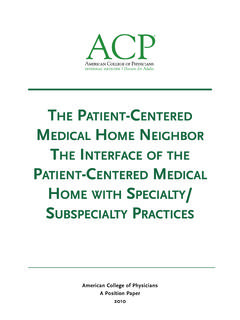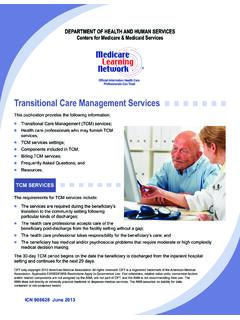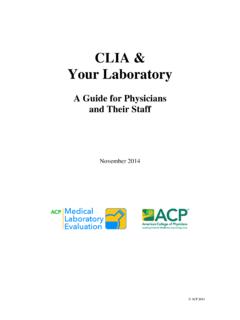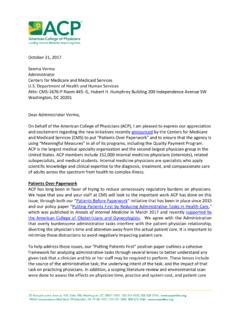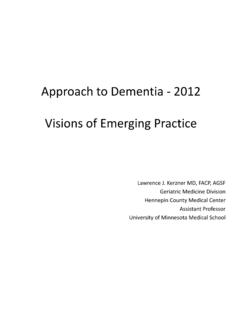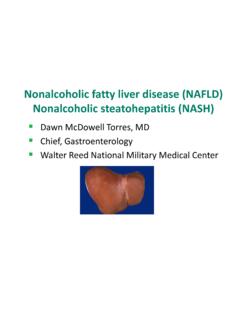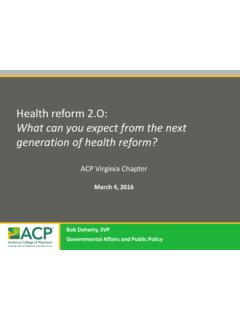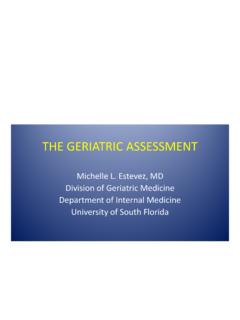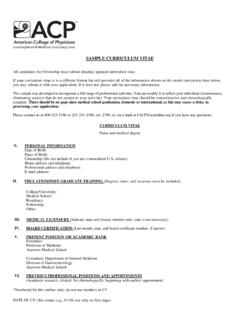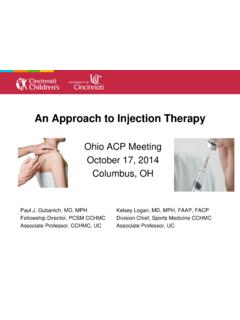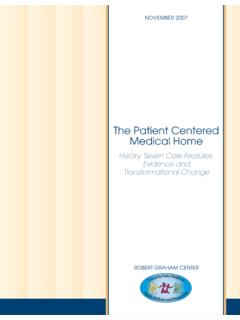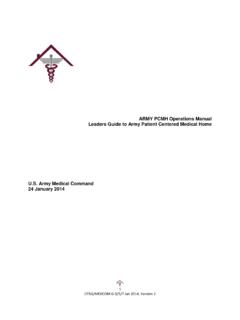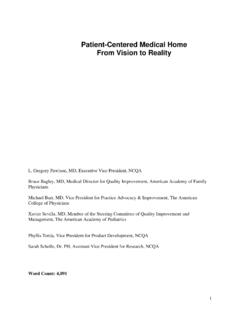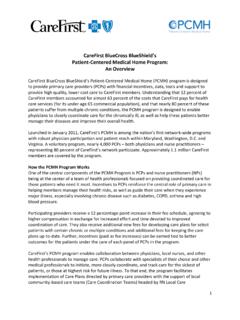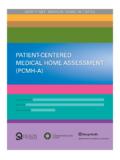Transcription of The Patient Centered Medical Home (PCMH): Overview of …
1 8/3/20101 The Patient Centered Medical home (PCMH): Overview of the Model and Movement Part IJuly 2010 Shari M. Erickson, MPHS enior Associate, Center for Practice Improvement & InnovationAmerican College of PhysiciansPresentation OutlinePart I:Why the Patient - Centered Medical home (PCMH)?What is the PCMH?How do I know a PCMH when I see it?Where does specialty care fit in?Part II:Who supports the PCMH model?Where is the PCMH model being tested?What have we learned about the PCMH so far?How can ACP help practices?8/3/20102 The Cost of American Healthcare8/3/20103 What about within the Significant Geographic VariationSource: The Dartmouth Atlas of Health Care. (2009). The Policy Implications of Variations in Medicare Spending Growth. Link: : Data adjusted for age, race, and sex but not price. Category definitions as in source 1: Medicare Spending per Beneficiary, by Hospital Referral Region, 2006 National Average = $8,304$7,500 $8,000$8,000 $9,000> $9,000$7,000 $7,500< $7,000 Not populatedStates with red circles have PC/Specialty Ratio of < with greencircles have PC/Specialty Ratio of > Demand for Health Care ServicesPopulation and service demand growing population projected to be 349 Million by 2025 902 million visits were made to physician offices in the US in 2006 - 2/3 Primary care - IM, Peds, and FP Insurance reform will expand coverageAging and chronically ill population 2011 10,000 seniors per day will become eligible for Medicare 83% of current Medicare patients have one or more chronic conditions 23% of current Medicare patients have 5 or more chronic conditions, account for ~ 3/4 of Medicare spending.
2 See about 14 different physicians in a year and have about 40 office visitsSOURCES: American College of Physicians. How Is a Shortage of Primary Care Physicians Affecting the Quality and Cost of Medical Care?. Philadelphia: American College of Physicians;2008: White Paper; Anderson GF. Medicare and Chronic Conditions. Sounding Board. N Engl J ;353(3):305-9; Order to See Real Need to Redesign How We Deliver Care andHow We Pay for It!8/3/20105 [Better] performance is not simply it is not even mainly a matter of effort;it is a matter of design -Don BerwickAdministrator of CMS(Former CEO, IHI)Presentation OutlinePart I:Why the Patient - Centered Medical home (PCMH)?What is the PCMH?How do I know a PCMH when I see it?Where does specialty care fit in?Part II:Who supports the PCMH model?Where is the PCMH model being tested?What have we learned about the PCMH so far?
3 How can ACP help practices?8/3/20106 What is the Patient - Centered Medical home ?Vision of primary care as it should beStrengthening the physician- Patient relationshipGetting patients the care they want and need when they need it Framework for organizing systems of care at both the micro (practice) and macro (society) levelModel to test, improve, and validateImportant component of more comprehensive reform (including accountable care organizations) Evolution of the PCMH Joint Principles These joint principles guide the collective actions of the organizations to further develop, promote, and test the PCMH ACP, AAFP, AAP, and AOA representing 330,000 physicians establish PCMH joint principles in March 2007 to provide standard definition of delivery model and describe the environment necessary to support itACP, American Academy of Family Physicians (AAFP), American Academy of Pediatrics (AAP)
4 , and American Osteopathic Association (AOA) have similar positions in promoting PCMH 8/3/20107 Joint Principles Personal physician in physician-directed practiceWhole person orientationCoordinated care, integrated across settingsQuality and safety emphasis Enhanced Patient access to careSupported by payment structure that recognizes services and valueTeam-based care: NP/PARN/LPNM edical AssistantOffice StaffCare CoordinatorNutritionist/EducatorPharmaci stBehavioral HealthCase ManagerSocial WorkerCommunity resourcesDM Neighbors Endorsing the Joint PrinciplesAmerican Academy of Hospice and Palliative Medicine American Academy of Neurology American College of Cardiology American College of Chest Physicians American College of Osteopathic Family Physicians American College of Osteopathic Internists American Geriatrics Society American Medical AssociationAmerican Medical Directors Association American Society of Addiction Medicine American Society of Clinical Oncology Association of Professors of MedicineAssociation of Program Directors in Internal MedicineClerkship Directors in Internal Medicine Infectious Diseases Society of AmericaSociety for Adolescent Medicine Society of Critical Care
5 Medicine Society of General Internal Medicine8/3/20108 Presentation OutlinePart I:Why the Patient - Centered Medical home (PCMH)?What is the PCMH?How do I know a PCMH when I see it?Where does specialty care fit in?Part II:Who supports the PCMH model?Where is the PCMH model being tested?What have we learned about the PCMH so far?How can ACP help practices?How do you Know a PCMH When you See One?Process needed to recognize practices that have and use the capability to provide Patient - Centered carePractice recognition provides purchasers (employers, government) and patients with prospectiveassurance that the practice has capabilities Recognized PCMHs would also be accountable for quality of care by reporting on evidence-based clinical and Patient experience measures provides retrospectiveassuranceNational Committee on Quality Assurance (NCQA) announced a voluntary recognition process based on its Physicians Practice Connection (PPC)
6 Module, the PPC-PCMH in January 2008 ACP, AAFP, AOA, and AAP helped NCQA develop the module Undergoing revisions now, with new version to be released in January 2011 Other entities are also developing PCMH recognition/accreditation processes The Joint Commission, URAC, CARF, AAAHC8/3/20109 NCQA PPC-PCMH Recognition Module; Major Domains/Standards & Tracking & Registry Self-Management Reporting & Electronic CommunicationEach standard contains sub-elements 10 of which are considered must pass For more information: : Building a Ladder to ExcellenceLevel 1: 25-49 Points; 5/10 Must PassLevel 2: 50-74 Points; 10/10 Must PassLevel 3: 75+ Points; 10/10 Must PassIncreasing Complexity of Services8/3/201010 NCQA Recognition Activity >1500 practices have received recognition 33% Level 1 5% Level 2 62% Level 358 % of practices have < 5 physicians at the site47% of practices are part of multi-sitesConcentration in the Northeast and Mid-South Practices more likely to seek recognition when/where tied to rewardAbout 66% are adult primary care practices; 15% are pediatric practices31 (17%) are community health centers SOURCE: NCQA, July 2010 Presentation OutlinePart I:Why the Patient - Centered Medical home (PCMH)?
7 What is the PCMH?How do I know a PCMH when I see it?Where does specialty care fit in?Part II:Who supports the PCMH model?Where is the PCMH model being tested?What have we learned about the PCMH so far?How can ACP help practices?8/3/201011 Complex DeliveryHealth care delivery is complex , the typical primary care physician coordinates care with 229 other physicians working in 117 practicesH H Pham, et al Ann Intern Med. 2009;150:236-242 Specialty Care ConnectionsPCMH is NOT a gatekeeper systemEmphasis on transitions in care & continuity ( , referral agreements, care transitions programs)ACP in discussions with several groups regarding the PCMH model and primary care/specialty care interface (sharing care)ACP Council of Specialty Societies PCMH workgroup: Developed FAQs on the relationship of the PCMH to specialty physicians* Facilitating the development of the PCMH Neighbor concept white paper to be released in late Summer/early Fall 2010* FAQs available at: You!
8 Shari M. Erickson, MPHS enior Associate, Center for Practice Improvement & InnovationAmerican College of Physicians25 Massachusetts Avenue, NW, Suite 700 Washington, DCPhone: 202-261-4551 Email.
